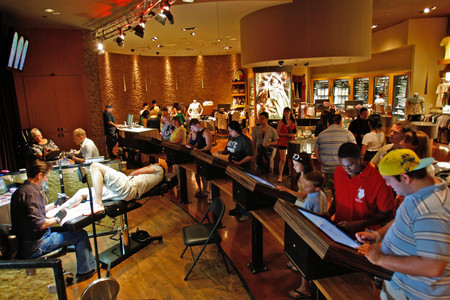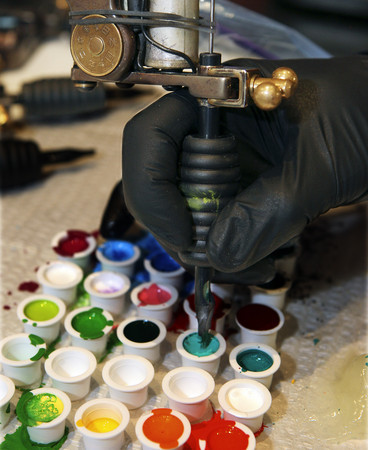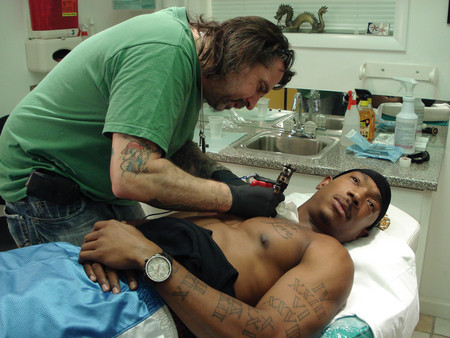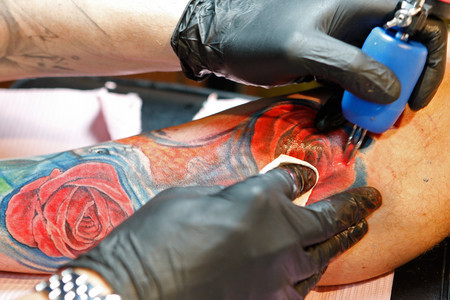Upscale tattoo parlors increase respectability of body art
tan Budlak, a 44-year-old retail salesman from Saylorsburg, Pa., strolls into Hart & Huntington. Adorned with granite countertops, recessed halogen lighting and mirror-embedded flat-screen TVs, the tattoo shop frequently is mistaken for the beauty salon next door.
"All the artists are booked for a while," receptionist Jenny Magerko tells him. "We can get you seated in about four hours."
Tattooing has gone high-rent. No longer are recipients required to splay out in fluorescent-lit downtown storefronts below men with more skulls on their arms than teeth in their heads. H&H -- owned by famed motocross racer Carey Hart -- is one of an expanding number of upscale ink parlors rimming the tourist corridor that employ tattoo artists as celebrated as their celebrity clients.
Other notably upscale shops include Club Tattoo at the Miracle Mile Shops at Planet Hollywood (co-owned by Linkin Park singer Chester Bennington), Huntington Ink at the Palms (owned by former H&H partner John Huntington), Vince Neil Ink at O'Sheas (owned by the notorious Motley Crue singer) and Starlight Tattoo at Mandalay Bay (owned by veteran tattoo artist Mario Barth, who also runs the annual Biggest Tattoo on Earth convention).
"The general public are getting softened with their preconception that tattooing is something negative," says Barth, who credits a slew of tattoo-themed reality TV shows that began with A&E's "Inked" in 2005 and now includes TLC's "Miami Ink" and "L.A. Ink," Discovery Real Time's "London Ink" and A&E's "Tattoo Highway."
"It's a voyeuristic situation," Barth says. "A lot of people are intrigued by seeing people get a tattoo, especially in the safety of their own home."
Indeed, Budlak took a cab to the Hard Rock Hotel from Paris Las Vegas because of "Inked," which documented the drama inside H&H when it operated at the Palms in 2005 and 2006.
"I used to watch the show all the time and I know what kind of work they do," Budlak says.
Although Budlak's job requires a professional appearance, he is shopping for his seventh tattoo.
"I wear long-sleeve shirts," he explains.
All the upscale Strip shops see more doctors and lawyers than bikers. "And they're the ones spending millions of dollars," Barth says, "which makes it possible for people like us to generate super, super high-end studios."
Like half of H&H's customers, Budlak walked right past the three touch-screen monitors displaying portfolios of potential artwork. He has his own idea in hand: a 3-inch-wide diamond covered by a yellow ribbon reading "In Memory of Edge." It's for his recently deceased brother. Magerko asks how realistic he wants the diamond to appear.
"People are getting more artistic tattoos as opposed to fly-by-night tattoos," says H&H artist Jime Litwalk, who has buzzed music notes onto the face of Papa Roach singer Jacoby Shaddix, the Lord's Prayer down the forearm of UFC fighter Quinton "Rampage" Jackson, and some letters he can't remember onto the chest of Maroon 5 singer Adam Levine.
"It's not something anymore where you just walk in and pick it and stick it," Litwalk says.
The first real wave of tattoo acceptance occurred 10 years ago, when celebs such as Dennis Rodman, David Beckham and Britney Spears co-opted body art from the realm of Hell's Angels, sailors and convicts. (The butterfly on Spears' left foot even was featured in a Pepsi commercial.) By 2007, according to a Pew Research Center poll, 36 percent of 18- to 25-year-olds and 40 percent of 26- to 40-year-olds sported at least one tattoo.
"The rough edge got chopped off a little bit at a time," Barth says, "and now it's disappeared." (Indeed, even Ray Johnson, the mayor of Campo, Colo., has nary a bare skin patch on his arms, torso or thighs.)
Budlak is quoted a price of $400 to $500 for 60 to 90 minutes of work, more than twice what he would probably pay a guy named Bubba downtown.
"That's pretty much what I expected," he says as he makes the appointment.
Lyle "Bumper" Kramer, a tattooer at Vince Neil Ink, says that customers at upscale shops have more money to discriminate.
"They're starting to realize that it's not like they're going to get the same thing for a different price," he says. "When it comes to tattooing, you get what you pay for. And it's going to be on your body for the rest of your life."
The upscaling of the business doesn't seem to be hurting more traditional shops, either. Respected tattoo artist Robert Pho, 38, has run his own eastside inkery since 2005 and says he has a six-month waiting list.
"It's good for all of us," Pho says. "It hypes it up more, brings more advertising for us."
Contact reporter Corey Levitan at clevitan@reviewjournal.com or 702-383-0456.





















